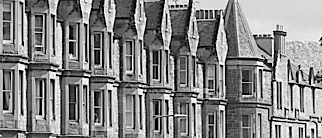The average selling price of a house in east central Scotland increased by 2% in 2016, compared with 5.6% in 2015, according to the ESPC.
The moderate price growth was partly explained “by average selling prices in 2015 being driven up by higher end properties being sold before the implementation of the tax changes with Land and Building Transaction Tax (LBTT),” said ESPC.
Comparing like-for-like properties, rather than overall averages, there was a 5.2% increase in average selling prices for one bedroom flats, a 2.5% increase for two bedroom flats and a 4.5% increase for three bedroom houses.
The number of homes sold in east central Scotland last year fell 6.7%, the first decrease in volumes since the recovery from the financial crisis of 2007-2008.
In 2015 the number of homes sold rose by 9.8%, so the 2016 decrease “could be a result of less housing stock available and the effect of changes to LBTT,” said ESPC.
The median selling time for a house in east central Scotland in 2016 was 39.6% faster than 2015 — down to 25 days from 41 days.
About 66% of sales in 2016 met or exceeded their Home Report valuation, up 14.7% from the previous year.
“The property market in 2016 proved to be in favour of the seller, as a shortage of stock resulted in homes selling much faster than in previous years, and with an increase in properties achieving on or above their Home Report valuation,” said ESPC.
Three bedroom houses in Currie, Balerno and Juniper Green saw the largest year-on-year increases in average selling prices, up 15.2% from 2015 — despite the number of sales staying about the same.
Paul Hilton, CEO of ESPC, said: “When overviewing 2016, the standout is that it was a seller’s market, with less properties on the market, rising selling prices, faster selling times and more properties for sale meeting or exceeding their home report valuation.
“While we are seeing a decrease in properties sold for the first since the recovery from the 2008 crash, this is mostly a result of the tightening of stock on the market, which some have attributed to the introduction of higher LBTT tax rates for upper middle properties.
“This has dampened the traditional property ladder patterns of buying up and replenishing active stock on the market …
“Possible impacts on the property market include the housing shortage, which could continue to impact on prices and active stock.
“There is also the potential impact of the triggering of Article 50. We will have to wait and see what the year has in store.”
